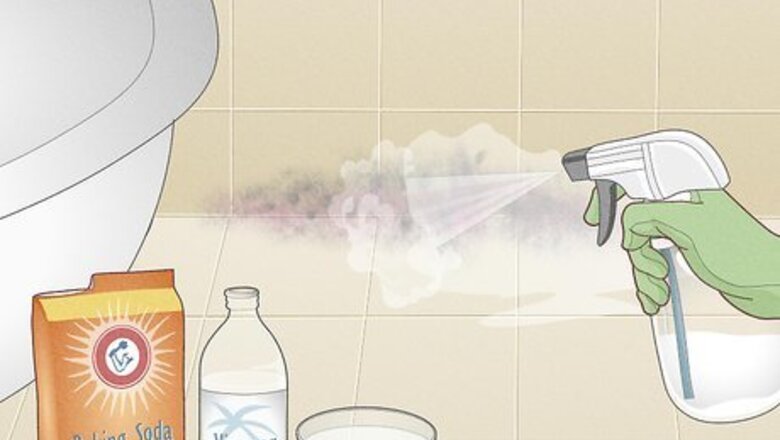
views
How do I get mold and mildew off of bathroom walls?
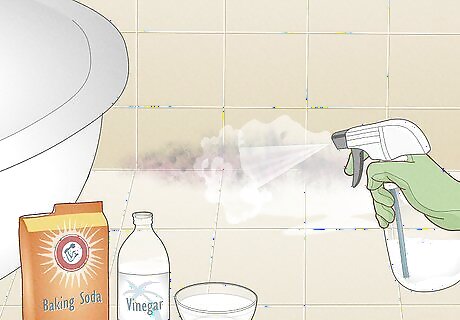
Spray hydrogen peroxide or a baking soda solution on the mold. Put either 3% hydrogen peroxide or a solution of 2 parts baking soda, 1 part white vinegar, and 1 part water into a spray bottle. Apply your solution directly onto the wall that has mold or mildew on it. Wait at least 10 minutes for the solution to work before scrubbing it off in circular motions with a medium-bristle brush. Avoid using bleach on walls since it won’t reach mold that’s deeper than the surface.
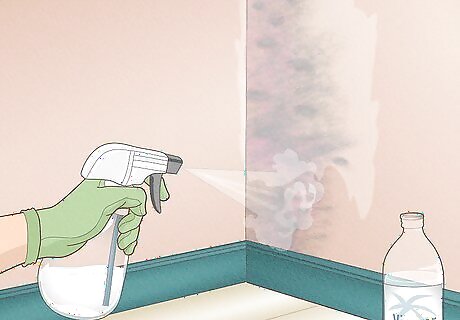
Penetrate deeper mold growth with undiluted vinegar. Since the mold may have grown into the drywall, it will come back if you leave it untreated. Put white vinegar into a spray bottle and liberally apply it to the entire area you just cleaned. Leave the vinegar to air-dry and disinfect the area so the mold doesn’t return. Vinegar actually kills up to 80% of mold species! Don’t worry about the vinegar smell. It will disappear as soon as it completely dries. If the room doesn’t get good ventilation or airflow, set up a box fan pointed at the wall and let it run for 24 hours. Reader Poll: We asked 19 just like you a simple question: what's the best chemical solution for cleaning white mold? Their options were… Bleach and water Borax and water Baking soda and water 3% hydrogen peroxide Undiluted, distilled white vinegar…And 12 readers agreed that undiluted, distilled white vinegar is the best way to remove white mold for good. That means that 63% of real people just like you swear by that DIY method. The more you know!

Remove and replace the drywall if it’s soft to the touch. After you clean the drywall, gently push on it with your fingers. If it easily moves or feels soft, the mold may be a larger issue and you won’t be able to fix it. Take out the drywall that’s affected and check if the wall framing has mold. Clean any other mold you find before installing a new piece of drywall. Don’t leave moldy drywall up since it could keep spreading inside your walls.
How do I clean mold and mildew off of wood?
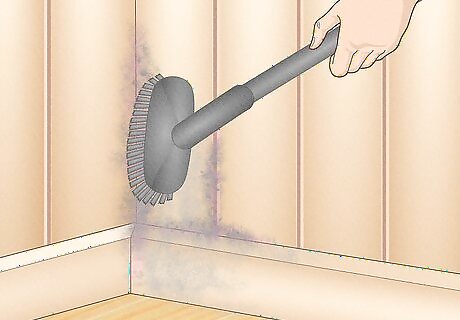
Start by vacuuming the area to clean loose spores. Use a vacuum that has a HEPA filter since it prevents the spores from spreading in the air. Run the hose attachment over the area covered with mold to get rid of any loose sections on the surface of the wood. Try to remove as much as you can with your vacuum so you have less to clean later on. Immediately throw the vacuum bag away or empty the canister into a plastic bag outside.

Try scrubbing it with dish detergent and water. Mix a few drops of a mild liquid dish detergent with warm water in a bucket until suds form. Dip the bristles of a soft brush into the water and start gently working the soap into the wood. Work in circular movements to scrub away mold that’s still left on the surface. This works best on stained or painted wood since the mold doesn’t penetrate past the surface.

Tackle deep mold penetration with diluted vinegar or borax. Mix equal parts vinegar and warm water in a spray bottle and spread it over the mold. Let the solution sit on the wood for 1 hour before wiping it with a moist towel. Alternatively, you can try mixing 1 tablespoon (1.73 g) of borax with 1 cup (240 ml) of water and spreading it on the mold with a soft brush. Let the borax dry completely on the wood. If there’s still stubborn mold, take 100-grit sandpaper and rub out the affected section of wood.
How do I get mold and mildew out of furniture?
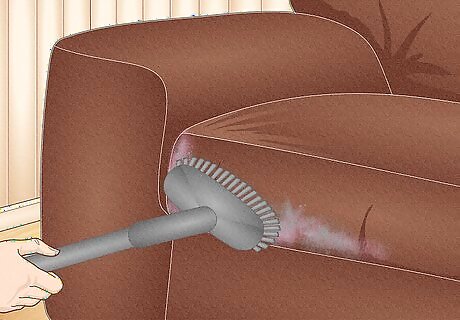
Vacuum the furniture thoroughly. Use a hose attachment on your vacuum to go over all of the areas where you see mold growth to get rid of the spores. Get rid of as much of the visible mold as possible so you don’t have as much to clean later on. Once you finish, empty the vacuum outside so you don’t spread the spores in your home again. Mold may be deeper in the cushions or batting of upholstered furniture, so a vacuum may not work on it’s own. You can try cleaning it further or replacing the furniture entirely.
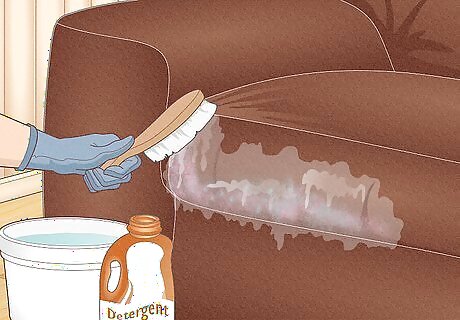
Work mild detergent into the furniture with a gentle brush. Take a mild laundry detergent or dish soap and add a few drops to a bucket of water. Mix the solution until suds form on the surface. Take a soft brush and dip the bristles in only suds. Gently work the suds into the moldy section of your furniture to help remove the mold. Wipe the suds off with a clean, damp cloth and let the furniture air-dry completely. Try moving your piece of furniture outside to clean if it’s sunny. The sunlight helps dry the piece faster and also prevents mold spores from spreading in your home.

Replace or professionally restore furniture if it still has a musty smell. Mold may have gotten deeper into the cushions of upholstered furniture and might still grow mold. After you clean it, if you ever notice a wet or musty smell on your furniture, it’s a sign the mold came back. You can either pay a professional to take the furniture apart and reupholster it, or you can just throw it away and replace it. It can be really difficult to save furniture that’s moldy or water-damaged, so sometimes, replacing it is the best option.
How do I kill mold and mildew on fabric?

Use a vacuum with a HEPA filter to remove residue. If the fabric is wet, wait until it’s dry before you start vacuuming. Turn your vacuum onto the lowest suction and pull out the hose attachment. Gently go over the area with mold using the hose attachment to get the spores and loose mold out from the fibers of the fabric. If you’re worried about damaging the fabric, test your vacuum on a small inconspicuous area first.
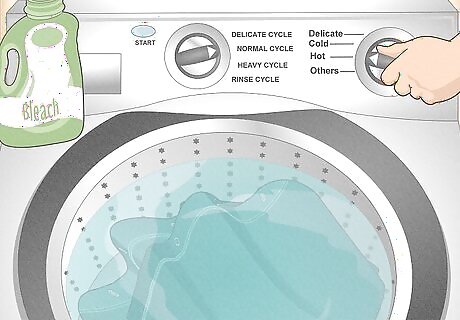
Wash the fabric on the hottest temperature setting with bleach. Check the laundry tag on the fabric and set your washing machine to the hottest cycle the fabric can tolerate. Use your standard laundry detergent for the load. Add the amount of bleach recommended on the product packaging to your machine and run the cycle. When it’s finished, dry the fabric thoroughly. If you can’t put the fabric in your machine, like if you have mold on a carpet, then instead have someone professionally shampoo or clean them. Mold can cause stains or permanent damage to fabric.
Can I paint over mold and mildew?
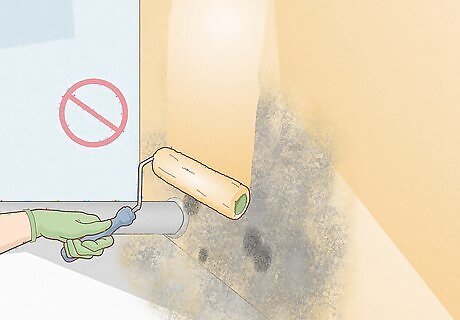
No, mold or mildew can keep growing under the paint. Always treat the mold completely before refinishing the surface you found it on. Since the paint traps the mold underneath, it could still grow in your walls or cause the paint to peel. If you want to paint over an area you completely cleaned, opt for mold-resistant paint to help prevent mold growth in the future.
How do I stop mold and mildew from growing back?
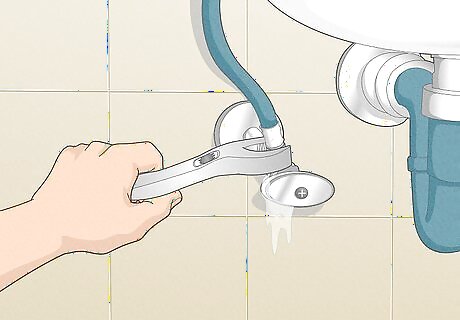
Fix any water leaks in your home. Mold and mildew thrive in moisture, so check that you don’t have any leaks or standing water in your home. If you find any, hire a plumber to fix them for you so you don’t have to worry about mold developing again. If you have a larger problem where moisture gathers, like an unfinished basement, you may need to install waterproofing as well to keep moisture out. If you have a dirt crawlspace, install a plastic cover to keep moisture from coming up from the ground. Sometimes, water can come in if your landscaping slopes toward your home. Contact a landscaping service to help correct this issue.
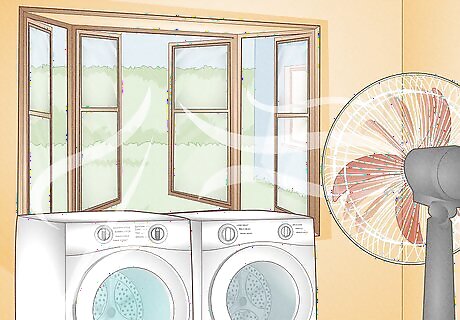
Keep air flowing through your home. Whenever you’re in a room that has high humidity, such as a bathroom, laundry room, or kitchen, make sure you run a ventilation fan or open a window. Keep on fans, air conditioners, or dehumidifiers so there’s good airflow, or else mold spores will find somewhere to grow. Avoid keeping carpet or upholstery in any room that you can’t easily ventilate since mold will form more easily.

Clean your home regularly to get rid of mold spores. Mold has a much tougher time growing if you’re consistently cleaning areas where it could form. Make a routine to clean your home at least once a week. Try to focus on areas that have high humidity or moisture levels, especially in your laundry room, bathroom, and kitchen. Use an anti-fungal cleaner at least once a month to help kill spores.
What is the difference between mold and mildew?
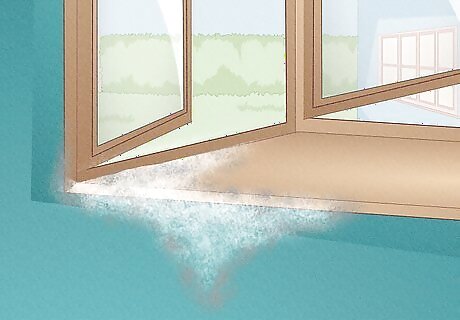
Mildew is powdery and grows more on the surface. Inspect the affected area to see if the spot grows flat against the surface. Mildew tends to look white or gray, and it has a dry or powdery texture when you touch it. Luckily, mildew doesn’t penetrate deep into a material so it’s easier to clean. Since mildew is a type of fungus like mold, you can use the same methods to clean it. You’ll typically find mildew in places with high humidity, such as basements, windowsills, and bathrooms.
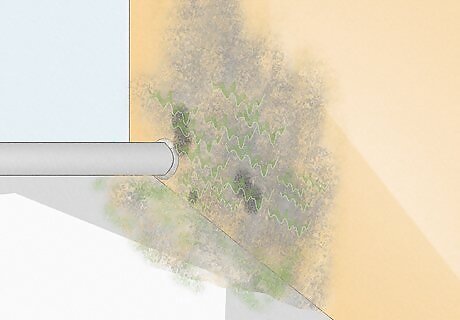
Mold looks slimy or fuzzy and can be more dangerous. Carefully inspect the spot to see if it looks raised from the surface. It may be green, red, blue, or black. Mold penetrates deeper into the material and causes damage that’s more difficult to repair and completely remove. Exposure to mold can lead to headaches, skin irritation, and respiratory issues if you leave it untreated. Mold also has a pungent musty odor, so it’s easy to detect.
Can I remove mold and mildew myself?
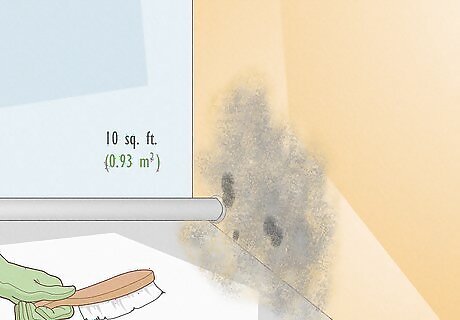
You can if the mold covers less than 10 square feet (0.93 m). Measure the area that’s covered in mold or mildew to find out how much area it covers. For a smaller area, you can safely remove and clean most mold problems with household materials. However, reach out to a mold specialist or professional cleaner if you’re dealing with a large area since it’s more difficult to remove on your own. You should also hire a professional if the area was exposed to sewage or you can’t find the mold on your own.
How do I protect myself while cleaning mold and mildew?

Put on gloves, goggles, and a respirator. Get safety goggles that completely cover your eyes and are tight to your skin so the spores don’t cause eye irritation. Since the spores can damage your respiratory system, fit an N-95 respirator over your mouth and nose and make sure it sits tightly against your skin. Finally, wear some rubber gloves so you don’t get any mold on your skin. Protective gear also helps protect you from fumes created by the cleaning supplies you use.




















Comments
0 comment